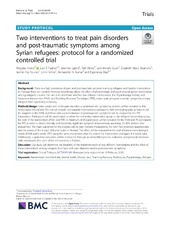| dc.contributor.author | Hasha, Wegdan | en_US |
| dc.contributor.author | Fadnes, Lars Thore | en_US |
| dc.contributor.author | Igland, Jannicke | en_US |
| dc.contributor.author | Vårdal, Rolf | en_US |
| dc.contributor.author | Giusti, Line | en_US |
| dc.contributor.author | Strømme, Elisabeth Marie | en_US |
| dc.contributor.author | Haj Younes, Jasmin | en_US |
| dc.contributor.author | Heltne, Unni Marie | en_US |
| dc.contributor.author | Kumar, Bernadette Nirmal | en_US |
| dc.contributor.author | Diaz, Esperanza | en_US |
| dc.date.accessioned | 2020-08-03T12:45:22Z | |
| dc.date.available | 2020-08-03T12:45:22Z | |
| dc.date.issued | 2019 | |
| dc.Published | Hasha, Fadnes, Igland, Vårdal, Giusti, Strømme, Haj Younes, Heltne, Kumar, Diaz. Two interventions to treat pain disorders and post-traumatic symptoms among Syrian refugees: protocol for a randomized controlled trial. Trials. 2019;20:784 | eng |
| dc.identifier.issn | 1745-6215 | |
| dc.identifier.uri | https://hdl.handle.net/1956/23367 | |
| dc.description.abstract | Background: There is a high prevalence of pain and post-traumatic symptoms among refugees and feasible interventions to manage these are needed. However, knowledge about the effect of physiotherapy and psychological group interventions among refugees is scarce. Our aim is to determine whether two different interventions, the Physiotherapy Activity and Awareness Intervention (PAAI) and Teaching Recovery Techniques (TRT), reduce pain and post-traumatic symptoms among refugees from Syria living in Norway. Methods/design: Syrian adults with either pain disorders or post-traumatic symptoms, or both, will be recruited to this randomized control trial. The trial will include two separate interventions: participants with dominating pain symptoms will be assigned to the PAAI; and those with a predominance of post-traumatic symptoms will be assigned to the TRT intervention. Participants will be randomized to either the immediate intervention group or the delayed intervention group, for each of the interventions (PAAI and TRT). A minimum of 68 participants will be recruited for the PAAI and 78 participants for TRT, in order to detect clinically and statistically significant symptom improvement, assuming 25–30% attrition after recruitment. The main outcomes for the analyses will be pain intensity measured by the Brief Pain Inventory questionnaire and the scores of the Impact of Events Scale — Revised. The effect will be evaluated at the end of interventions lasting 8 weeks (PAAI) and 6 weeks (TRT) using the same instruments after the end of the intervention, and again 4–6 weeks later. Additionally, a qualitative evaluation will be conducted through an embedded process evaluation and personal interviews with participants after each of the interventions is finished. Discussion: Our study will determine the feasibility of the implementation of two different interventions and the effect of these interventions among refugees from Syria with pain disorders and/or post-traumatic symptoms. | en_US |
| dc.language.iso | eng | eng |
| dc.publisher | BioMed Central | eng |
| dc.rights | Attribution CC BY | eng |
| dc.rights.uri | http://creativecommons.org/licenses/by/4.0 | eng |
| dc.title | Two interventions to treat pain disorders and post-traumatic symptoms among Syrian refugees: protocol for a randomized controlled trial | en_US |
| dc.type | Peer reviewed | |
| dc.type | Journal article | |
| dc.date.updated | 2020-01-29T07:21:09Z | |
| dc.description.version | publishedVersion | en_US |
| dc.rights.holder | Copyright 2019 The Author(s) | |
| dc.identifier.doi | https://doi.org/10.1186/s13063-019-3919-x | |
| dc.identifier.cristin | 1770875 | |
| dc.source.journal | Trials | |

